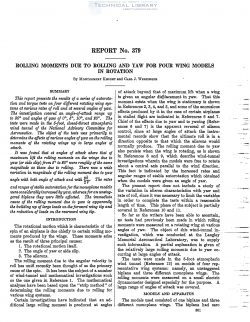naca-report-379

- Version
- 177 Downloads
- 1.71 MB File Size
- 1 File Count
- August 25, 2016 Create Date
- August 25, 2016 Last Updated
National Advisory Committee for Aeronautics, Report - Rolling Moments Due to Rolling and Yaw for Four Wind Models in Rotation

This report presents the results of a series of antorota—
tion and torque tests on four diferent rotating wing sys—
tems at various rates of roll and at several angles of yaw.
The investigation covered an angle-of-at-taelc range up
to 90° and angles of yaw of 0°, 5°, 10°, and 20°. The
tests were made in the 5-foot, closed-throat atmospheric
wind tunnel of the National Advisory Committee for
Aeronautics. The object of the tests was primarily to
determine the ejects of various angles quaw on the rolling
moments of the rotating wings up to large angles of
attack.
It was found that at angles of attach: aboce that of
maximum lift the rolling moments on the wings due to
yaw (or side slip) from 5° to 20° were roughly of the same
magnitude as those due to rolling. There was a wide
variation in magnitude of the rolling moment due to yaw
angle with both angle of attack and with 5%. The rates
and ranges of stable autorotationfor the mongplane models
wereconsiderably increased by yaw, whereas for an anstag-
gered biplane they were little afected. The immediate
cause of the rolling moment due to yaw is apparently
the building up of large loads on the forward wing tip and
the reduction. of loads on the rearward wing tip.
The rolling moment due to the angular velocity in
roll has until recently been thought of as the primary
cause of the spin. It has been the subject of a number
of wind-tunnel and mathematical investigations such
as the one given in Reference 1. The mathematical
analyses have been based upon the “strip method” of
determining the rolling moments due to rolling for
various wing systems.
Certain investigations have indicated that an ad-
ditional large rolling moment is produced at angles
of attack beyond that of maximum lift when a wing
is given an angular displacement in yaw. That this
moment exists when the wing is stationary is shown
in References 2, 3, 4, and 5, and some of the anomalous
eflfects produced by it in the case of certain airplanes
in stalled flight are indicated in References 6 and 7.
| File | Action |
|---|---|
| naca-report-379 Rolling Moments Due to Rolling and Yaw for Four Wind Models in Rotation.pdf | Download |

Comment On This Post